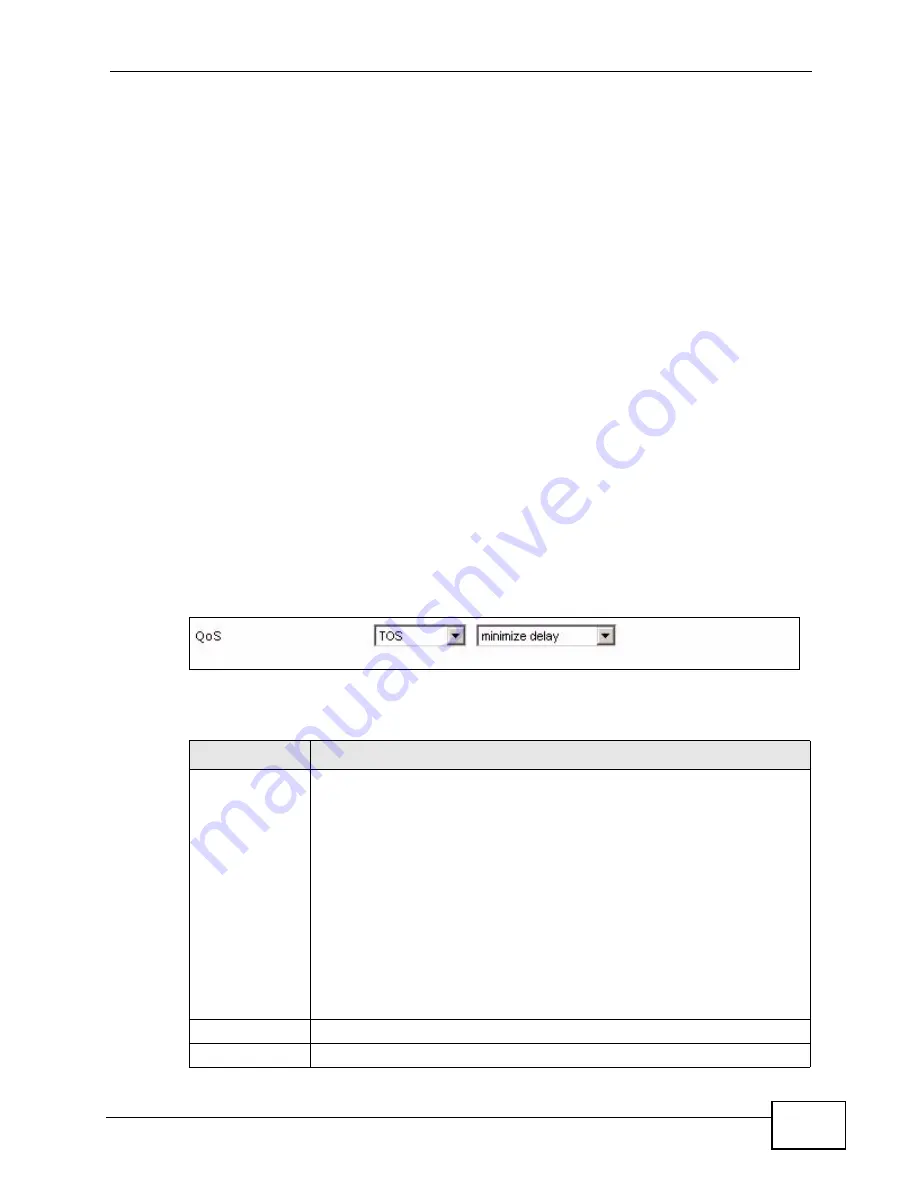
Chapter 8 QoS
X2002 User’s Guide
169
Expedited Forwarding (EF)
-
The EF PHB defines a single DSCP designed for
simulating a private end-to-end pipeline across a DiffServ network. IP packets are
marked for high priority low-loss, low-latency, low-jitter, assured-bandwidth end
to end service through DS domains. This is recommended for use with VoIP traffic
as it addresses the factors that cause degradation in sound quality.
Class Selector (CS)
-
IP packets are marked with values partially backwards-
compatible with known current uses of IP precedence field. The packets marked
with higher values are given higher priority than those with lower values.
8.1.3 Before You Begin
Before you start configuring QoS on your X2002, you should know the type of QoS
your network uses, and the relevant setting that you want to assign to the
X2002’s traffic.
8.2 The QoS Screen
Use this screen to set up the QoS settings on the X2002. To access this screen,
click
Configuration > PBX > Server Configuration > QoS
.
Figure 76
Server Configuration > QoS
Each field is described in the following table.
Table 41
Server Configuration > QoS
LABEL
DESCRIPTION
QoS
Select the QoS method you want to use to mark outgoing frames on the
X2002.
You can choose:
•
TOS
and then select one of the four classes of service supported on
the X2002:
minimize delay
,
maximize throughput
,
maximize
reliability
or
minimize cost
.
•
DS
(DiffServ) and then select the DSCP value to mark the outgoing
packets. You can choose: one of the
AF
(Assured Forwarding),
EF
(Expedited Forwarding) or one of the
CS
(Class Selector) values.
•
User Define
and then enter a value to assign to the ToS field in
decimal notation. You can set the value to a value from 0 to 255. The
X2002 displays the value you enter in hexadecimal notation.
•
None
, if you do not want to mark the ToS field of the outgoing VoIP
packets.
Apply
Click this to save your changes.
Reset
Click this to set every field in this screen to its last-saved value.
Summary of Contents for X2002
Page 2: ......
Page 24: ...Table of Contents X2002 User s Guide 24...
Page 25: ...25 PART I User s Guide...
Page 26: ...26...
Page 40: ...Chapter 2 How It Works X2002 User s Guide 40...
Page 99: ...99 PART II Technical Reference...
Page 100: ...100...
Page 124: ...Chapter 5 Network Deployment X2002 User s Guide 124...
Page 166: ...Chapter 7 Auto Provision X2002 User s Guide 166...
Page 170: ...Chapter 8 QoS X2002 User s Guide 170...
Page 248: ...Chapter 16 Click To Talk Group X2002 User s Guide 248...
Page 252: ...Chapter 17 Group Access Code X2002 User s Guide 252...
Page 304: ...Chapter 19 Auto Attendant X2002 User s Guide 304...
Page 312: ...Chapter 20 LCR X2002 User s Guide 312...
Page 346: ...Chapter 22 Call Services X2002 User s Guide 346...
Page 380: ...Chapter 25 Status Observation X2002 User s Guide 380...
Page 402: ...Chapter 27 Call Detail Record CDR X2002 User s Guide 402...
Page 410: ...Chapter 28 ACD Logs X2002 User s Guide 410...
Page 416: ...Chapter 29 Administrator Accounts X2002 User s Guide 416...
Page 424: ...Chapter 30 Diagnostics X2002 User s Guide 424...
Page 426: ...Chapter 31 X2002 User s Guide 426...
Page 446: ...Chapter 32 Remote Management X2002 User s Guide 446...
Page 448: ...Chapter 33 TFTP Management X2002 User s Guide 448...
Page 462: ...Chapter 35 License Control X2002 User s Guide 462...
Page 482: ...Chapter 36 Web Portal X2002 User s Guide 482...
Page 508: ...Chapter 39 Product Specifications X2002 User s Guide 508...
Page 548: ...Appendix C Legal Information X2002 User s Guide 548...
Page 562: ...Index X2002 User s Guide 562...






























